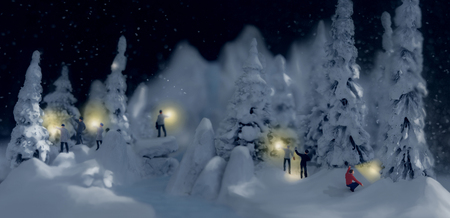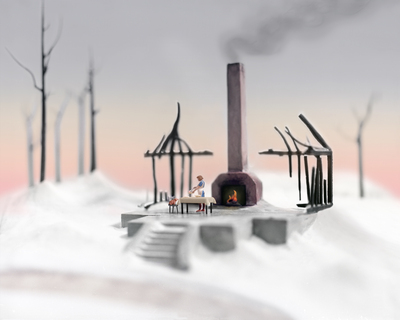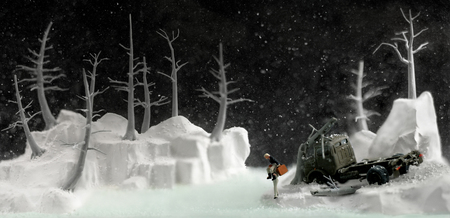U-M Institute for the Humanities exhibit offers decidedly dark take on snow globes in 'White Nights'

"The Search"
courtesy of the University of Michigan Institute for the Humanities
There’s a lot of psychology involved in the fascination of toy snow globes. Just remember the famous globe with the disconcerting impact in “Citizen Kane.”
Let’s just say mixed-media artists Walter Martin and Paloma Muñoz are doing their part to equally jar us with their “White Nights” exhibit at the University of Michigan Institute for the Humanities. This couple’s seven snow globes and seven mounted C-prints in this U-M exhibition space trace a snow-laden territory whose existential meanings are drenched with dread—or at least surreal fantasy.
As Humanities Institute arts curator Amanda Krugliak says in her statement on the display, “In the winter of 2001, artists Walter Martin and Paloma Muñoz moved from their loft in Brooklyn into an old house in the Delaware Highlands of Pennsylvania. Though only 70 miles from New York City, their new dwelling was at least a world or two away isolated by harsh winters and an entirely different cultural landscape.
“Martin and Muñoz channeled the strangeness and anxiety of this shifting reality into a body of work that began around a series of snow globes. Later, they restaged and photographed the scenes, not as documentation but as windows into that world.”
As Krugilak’s comments indicate, Martin and Muñoz’s snow globes are a bit more than initially meets the eye. Each sphere features tiny figures inhabiting snowy landscapes; covered with a coat of water-resistant resin, and thereafter set in a good-sized globe of water. Yet what started as globe miniatures also become oversized color pictorial panoramas, as Martin and Muñoz work from their initial miniatures to create computer-generated C-print vistas.
The staging and restaging of these tableaus gives “White Nights” its unusual dynamic. For the peculiarity of these works rests in their uneasy tension rising from otherwise events.
When Martin and Muñoz choose to craft greater flights of fantasy, they use their snowy background to heighten nightmares and bring a muted surrealism to the fore. Ultimately, “White Nights” are the things we suffer alone in the dark.

"Odd Couple"
Take the seemingly innocuous 2009 snow globe “Traveler 265” featuring a group of children with hands interlocked in a harmless youthful game of “ring-around-the-rosy.” That is, harmless until it’s remembered the game had its origin during the period of London’s great bubonic plague of 1665 when the symptom of a red rash on the skin in the shape of a ring typically presaged death. A closer inspection of the globe thereafter finds these children dressed far too lightly for the wintry season, with their background dwellings being ghostly mounds of snow.
More unusual is 2010’s C-print “Odd Couple,” where a housewife serves dinner to a seated, seemingly satisfied pig. This would be peculiar enough, but both pig and housewife are situated in a burnt house whose only standing remnant is a blazing fireplace. A background stand of stripped trees adds to the desolation, but it’s the housewife’s willingness to be of service that’s ultimately the most jarring aspect.

"Crossing the Watery Glass at Night"
Ultimately, the harrowing commonplace serves as Martin and Muñoz’s artistic signature in this display. 2002’s C-print “Crossing the Watery Glass at Night” and 2009’s C-print “The Search” sum up this couple’s adventures into visual alienation.
In the former print, one person is hoisted on the shoulders of another after their truck has crashed into a tree by the side of a frozen river. Neither fellow is particularly well dressed for such a night—and the dominance of one over the other with brown case in hand, indicates this “Crossing the Watery Glass at Night” is at best a nocturnal activity that’s somehow gone awry.
Still, 2009’s “The Search” is easily the single most harrowing artwork on display in “White Nights.” Indeed, it wouldn’t be far from wrong to say the exhibit’s been tacitly named for this masterwork.
A group of men seek someone (or something) on a desolate, snowy night in this C-print based on a Martin and Munoz snow globe. That is, their flashlights only find an open-ended absence in a stand of trees of what appears to be a fruitless search. And it may well be this lacking that’s the most terrifying loss of all—because it’s precisely this sort of mystery that “White Nights” is ultimately about.
“White Nights: Walter Martin and Paloma Muñoz” will continue through March 16 at the University of Michigan Institute for the Humanities’ Exhibition Space, Room 1010, 202 S. Thayer St. Gallery hours are 9 a.m.-5 p.m. Monday-Friday. For information, call 734-936-3518.


Comments
LA
Mon, Feb 21, 2011 : 2:22 p.m.
Sounds great! Can't wait to see it!